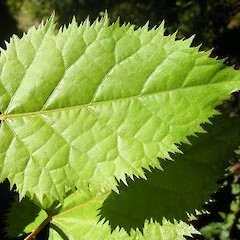Aristotelia serrata
Common name
makomako, wineberry
Family
Elaeocarpaceae
Flora category
Vascular – Native
Endemic taxon
Yes
Endemic genus
No
Endemic family
No
Structural class
Trees & Shrubs - Dicotyledons
NVS code
The National Vegetation Survey (NVS) Databank is a physical archive and electronic databank containing records of over 94,000 vegetation survey plots - including data from over 19,000 permanent plots. NVS maintains a standard set of species code abbreviations that correspond to standard scientific plant names from the Ngä Tipu o Aotearoa - New Zealand Plants database.
ARISER
Chromosome number
2n = 28
Current conservation status
The conservation status of all known New Zealand vascular plant taxa at the rank of species and below were reassessed in 2017 using the New Zealand Threat Classification System (NZTCS) – more information about this can be found on the NZTCS website. This report includes a statistical summary and brief notes on changes since 2012 and replaces all previous NZTCS lists for vascular plants.
Please note, threat classifications are often suggested by authors when publications fall between NZTCS assessment periods – an interim threat classification status has not been assessed by the NZTCS panel.
- Conservation status of New Zealand indigenous vascular plants, 2017 . 2018. Peter J. de Lange, Jeremy R. Rolfe, John W. Barkla, Shannel P. Courtney, Paul D. Champion, Leon R. Perrie, Sarah M. Beadel, Kerry A. Ford, Ilse Breitwieser, Ines Schönberger, Rowan Hindmarsh-Walls, Peter B. Heenan and Kate Ladley. Department of Conservation. Source: NZTCS and licensed by DOC for reuse under the Creative Commons Attribution 4.0 International licence.
2017 | Not Threatened
Previous conservation statuses
2012 | Not Threatened
2009 | Not Threatened
2004 | Not Threatened
Brief description
Much-branced small tree with thin heart-shaped sharply toothed leaves flushed with pink on the underside
Distribution
Endemic. North, South and Stewart Islands. Throughout, but less common in drier areas.
Habitat
Lowland to montane forests. Often forming dense thickets following disturbance.
Wetland plant indicator status rating
Information derived from the revised national wetland plant list prepared to assist councils in delineating and monitoring wetlands (Clarkson et al., 2021 Manaaki Whenua – Landcare Research Contract Report LC3975 for Hawke’s Bay Regional Council). The national plant list categorises plants by the extent to which they are found in wetlands and not ‘drylands’. The indicator status ratings are OBL (obligate wetland), FACW (facultative wetland), FAC (facultative), FACU (facultative upland), and UPL (obligate upland). If you have suggestions for the Wetland Indicator Status Rating, please contact: [Enable JavaScript to view protected content]
FACU: Facultative Upland
Occasionally is a hydrophyte but usually occurs in uplands (non-wetlands).
Detailed description
Dioecious tree to c. 10 m tall; trunk and branches upright, to 30 cm diam.; bark smooth, grey, spotted with lenticels; branchlets light to dark red, pubescent. Leaves opposite to subopposite; petiole slender, to 50 mm long, greenish often flushed pink; midvein conspicuous above, raised below; secondary veins obvious and raised below giving surface a wrinkled uneven appearance; lamina membranous, 5-12 x 4-8 cm, glabrate (pubescence may persist on veins below), broad-ovate, margin deeply doubly and irregularly sharply serrate, tip acuminate, base cordate to truncate,upper surface light or dark green, undersides pale green, frequently infused with purple or pink. Juvenile leaves larger. Inflorescences conspicuous, axillary, flowers 4-6 mm diam., in panicles 6-10 cm long, on slender pubescent pedicels 5-10 mm long. Sepals 4, ovate, c. 3 mm long, pubescent, pink; petals 4, 3-lobed (often deeply), c. 9 mm long, white to light pink to red. Stamens many, on glandular minutely pubescent disc, not exceeding petals. Ovary 3-4- celled, styles 3-4. Fruit a c. 8-seeded fleshy depressed-obovoid berry, 5 x 4 mm, bright red to black. Seed irregularly angled, ventral surface flattened, cicular or broadly elliptic, 1.9-3.1 mm, surface irrregular, aril absent.
Similar taxa
Superficial similarity to Entelea arborescens which is only found in northern New Zealand and which has a single (usually) cork trunk and a less sharply-toothed margin. The leaves of this species are never pink-flushed. Superficial similarity also to Hoheria and Plagianthus species, but the bark of these species falls in thin stringy strips (this is also evident when branchlets are broken).
Flowering
September-December
Flower colours
Red/Pink, White
Fruiting
November-January
Life cycle
Fleshy berries are dispersed by frugivory (Thorsen et al., 2009).
Etymology
aristotelia: Named after Aristotle, the Greek philosopher and polymath
serrata: Saw-toothed
Attribution
Description adapted from Allan (1961), Heenan and de Lange (2006), Eagle (2000) and Webb and Simpson (2001).
References and further reading
Allan, H.H. 1961. Flora of New Zealand. Government Printer, Wellington
Heenan, P.B, de Lange, P.J. 2006. Pseudowintera insperata (Winteraceae), an overlooked and rare new species from northern New Zealand. NZ J. Botany 44: 89-98
Eagle, A. 2000. Eagle’s complete trees and shrubs of NZ. Te Papa Press, Wellington
Webb, C.J. & Simpson, M.J.A. 2001. Seeds of NZ gymnosperms and dicotyledons. Manuka Press, Christchurch.
NZPCN Fact Sheet citation
Please cite as: de Lange, P.J. (Year at time of access): Aristotelia serrata Fact Sheet (content continuously updated). New Zealand Plant Conservation Network. https://www.nzpcn.org.nz/flora/species/aristotelia-serrata/ (Date website was queried)


















